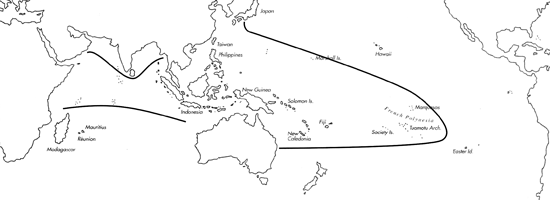
Skip Navigation Links
View access keys for this site.

Range: Red Sea and Central Indian Ocean to Polynesia.
Description: Moderately small to moderately large, moderately solid to solid. Last whorl conical; outline convex at adapical third, slightly concave at centre and straight below. Shoulder angulate to subangulate. Spire usually low, outline concave to convex. Teleoconch sutural ramps flat to slightly convex; later ramps with 3 increasing to 5 weak major spiral grooves, more often turning into numerous striae on latest ramps. Last whorl with rather regularly spaced, often finely granulose spiral ribs with closely set spiral striae betweenfrom base to adapical third.
| Shell Morphometry | ||
|---|---|---|
| L | 30-69 mm | |
| RW | 0.17-0.61 g/mm | |
| RD | 0.56-0.62 | |
| PMD | 0.89-0.94 | |
| RSH | 0.03-0.14 | |
Colour yellowish grey to orange and yellow. Last whorl often slightly paler near centre and at shoulder. Base and larval whorls purplish blue. Aperture white except for the basal area, occasionally tinged with violet deep within.
Periostracum brown, thick, opaque, and smooth or velvety.
Dorsum of foot white to yellow, lighter anteriorly, with shiny white dots and pale tan radial streaks centrally and posteriorly, and with a black spot beneath the operculum; marginal zone tannish orange, tan and broader but less solidly coloured posteriorly; anterior part with a pale to dark yellow distal edge and a large trilobate black blotch. Sole of foot white to light brown, mottled with brown, sometimes edged with yellow. Rostrum and tentacles white to bright yellow. Siphon white, sometimes grading to buff proximally, with 2 broad black rings on anterior half; tip often edged with yellow (Chaberman, pers. comm., 1981; Kohn, unpubl. observ.).
Radular teeth with an adapical barb opposite a blade; serration ending in a prominent cusp; base with a prominent spur (Nybakken, 1990).
Habitat and Habits: On intertidal benches and shallow subtidal reef flats; inhabiting sand bottoms, bare limestone or beachrock, and dead coral heads and rocks. C. emaciatus feeds on terebellid and other polychaetes (Kohn, 1968b; Kohn & Nybakken, 1975; Reichelt & Kohn, 1985; Sharabati, 1984).
Discussion: C. emaciatus is similar to C. virgo, which differs in its larger size (L 55-150 mm) and its more straight-sided last whorl with a weaker spiral sculpture. For the distinction from C. flavidus and C. frigidus, see the DISCUSSIONS of those species.

C. emaciatus range map
This section contains verbatim reproductions of the accounts of 316 species of Conus from the Indo-Pacific region, from Manual of the Living Conidae, by Röckel, Korn and Kohn (1995). They are reproduced with the kind permission of the present publisher, Conchbooks.
All plates and figures referred to in the text are also in Röckel, Korn & Kohn, 1995. Manual of the Living Conidae Vol. 1: Indo-Pacific Region.
The range maps have been modified so that each species account has it own map, rather than one map that showed the ranges of several species in the original work. This was necessary because each species account is on a separate page on the website and not confined to the order of accounts in the book.
Return to framed version (returns to search page)